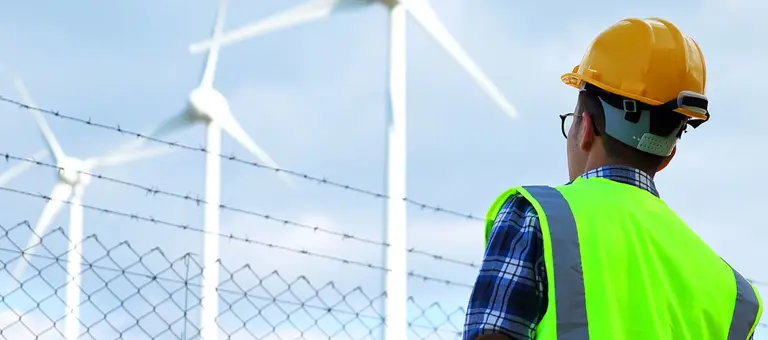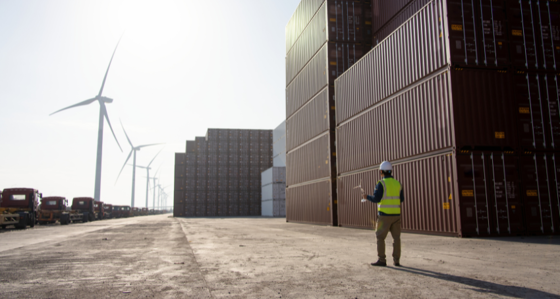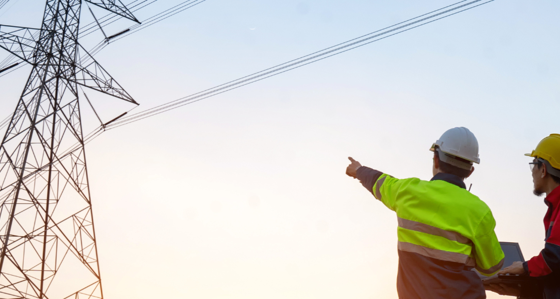
When the grid stops spinning: the inertia challenge in renewable energy
8 min read 30 September 2025
The global shift toward renewable energy is fundamentally reshaping our electrical grids. As we accelerate the deployment of wind, solar, and battery storage systems, we are simultaneously phasing out the traditional power plants that have provided essential grid services. This transition brings many benefits, but it also introduces a critical challenge: the loss of system inertia - a fundamental property that has kept our grids stable and resilient.
1. What is system inertia and why do we need it?
System inertia refers to the total amount of rotational kinetic energy stored in all spinning machines connected to the electrical grid. This energy acts as a natural shock absorber for the power system. When there is a sudden imbalance between electricity supply and demand, such as when a large generator unexpectedly trips offline or a major industrial load disconnects, inertia provides an automatic, instantaneous response that slows down frequency changes.
This automatic response is crucial because electrical grids must maintain frequency within very tight tolerances to function properly. Without adequate inertia, even small disturbances can cause rapid frequency swings that trigger protective systems to disconnect equipment, potentially leading to cascading blackouts. Inertia doesn't prevent frequency deviations, but it buys precious time (typically seconds to minutes) for grid operators to activate other stabilizing services and restore balance.
2. How traditional power plants provided inertia
Historically, synchronous generators at coal, gas, and hydro power stations have been the primary source of system inertia. These machines are directly connected to the power grid and feature large, heavy rotating masses that spin in perfect synchronization with the grid frequency. Because they store kinetic energy proportional to their moment of inertia and rotational speed, this energy is inherently available to resist sudden changes in frequency.
The beauty of this system was its simplicity: the stored rotational energy required no control systems, communication networks, or human intervention. It was a purely physical response - when the grid frequency started to change, the spinning masses would naturally resist this change. This made synchronous generators a natural and immediate source of grid stability.
3. The renewable energy challenge
As synchronous machines are retired and replaced with inverter-based resources like wind, solar, and battery systems, the amount of natural system inertia declines. These modern technologies do not rotate physically and therefore contribute no inherent inertia to the grid. This makes the power system more vulnerable to rapid frequency swings and increases the Rate of Change of Frequency (RoCoF) during disturbances.
With fewer synchronous generators on the grid, the system becomes increasingly sensitive to disturbances and requires faster-acting stabilizing services like fast frequency reserves to maintain stability.
4. Grid-forming inverters: promise and reality
In this context, grid-forming (GFM) inverters are often presented as a silver bullet for maintaining stability in renewable-heavy systems. Unlike traditional grid-following inverters, which depend on an existing grid frequency to operate, GFM inverters can establish and regulate frequency themselves - essentially "forming" the grid.
However, despite their promise, this technology is still evolving and faces key challenges in early deployments:
Technical integration challenges:
- Synthetic inertia from GFM inverters requires tight coordination, centralized control, and system-wide synchronization to be truly effective. However, current grid management digitalization still has significant gaps that limit our ability to fully realize this technology's benefits.
Operational mismatch:
- The midday solar peak in generation drives a chasm into system inertia as thermal plants are ramped down. During this time the two-way inertia providing capability of GFM coupled BESS theoretically have the opportunity to provide the necessary stability. However, as BESS are typically charged during midday with abundant solar generation, their inertia providing capability drops drastically as they reach their peak charging operating point. Essentially, an operational mismatch occurs as GFM BESS struggle to provide inertia in an over-frequency event, exactly when it is needed the most due the limited traditional inertia providing generation when the grid is flooded with renewable energy.
Economic and operational constraints:
- To counteract the mismatch between the GFM BESS operating point and required inertia output, operators must reserve capacity headroom in their scheduled commitments to provide synthetic inertia, limiting their revenue potential. Simply, batteries cannot charge at full capacity during midday low price hours if they aim to provide inertia. Thermal generators don’t face this revenue impact as their inertia provision does not (significantly) affect their operating point. Without additional support schemes specifically targeting GFM BESS, this creates a strong disincentive for deployment.
Market competition:
- Unlike GFM inverters, synchronous generators can provide inertia with minimal additional cost or technical complexity. However, as we transition to a renewables-based system we cannot rely on this existing source of inertia. However, similar to their power generating counterparts, synchronous condensers can also provide constant physical inertia to the system. These systems are made up of a spinning mass attached to an electric motor run in sync with the grid. These set-ups can either be newly built, or by retrofitting existing infrastructure of retired thermal plants. As Europe steadily decommissions coal plants, their existing turbines provide the opportunity to continue supporting grid stability at little additional cost.
- As governments attempt to tackle the inertia challenge, results from support schemes shed a light on the struggles facing the implementation of GFM inverters. Under UK's Stability Pathfinder procurement rounds as well as earlier stability tenders, where inertia provision was mandatory, GFM inverters were largely unsuccessful in winning contracts. In fact, only ~12% of UK’s contracted inertia will be met by GFM inverters by 2026, the rest being awarded to synchronous machines (mainly dominated by synchronous condensers). The upcoming market-based procurement of inertia in Germany in 2026 could lead to different results, as its remuneration system differentiates between inertia-providing technology types. However, it is still uncertain whether the remuneration rates for the participation of GFM inverters will be sufficient.
5. The path forward
GFM inverters have the potential to allow BESS to provide synthetic inertia, in a system dominated by grid following renewable generation. However, they are not the silver bullet they are sometimes made out to be. The timing mismatch between when inertia is needed vs when it can be provided, in conjunction with the opportunity cost of actually providing the inertia as well as the associated costs of the GFM inverters could represent major challenges facing this technology. With the ever-growing need for additional inertia, GFM inverters might find their place in the market, but it is crucial to evaluate both the strengths and weaknesses holistically. Market mechanisms need to properly value inertia services, creating sustainable revenue streams for storage operators providing grid stability. Technical standards must evolve to ensure seamless integration and interoperability. Most importantly, grid operators need enhanced digital infrastructure and real-time coordination capabilities to orchestrate these distributed resources effectively.
Synchronous machines (generators and condensers) have historically provided the necessary inertia to the system, but as we phase out thermal generation and add significant grid-following capacity, additional resources are needed to keep the grid stable. The solution lies not in choosing between technologies, but in developing hybrid approaches that leverage the strengths of both synchronous machines and advanced inverter systems during the transition period.
As European power markets decarbonise, the provision of system stability services will become more critical moving forward. Baringa has advised a wide range of clients in the UK on the various Stability Pathfinder rounds as well as in SEM on the Low Carbon Inertia Services (LCIS) phase 1 procurement round. We are excited to work with our clients across Europe, helping them realise the best commercial returns for their assets as other European grid stability markets start to develop.
Please reach out to Osamudiame Evbuomwan, Hendric Tronsson and Niklas Stumm to discuss how Baringa can help you navigate the European inertia and stability markets.
Want to keep up to date or get in touch?
Subscribe to our Energy and Resources Newsletter. Get industry news and trending topics direct to your inbox.
Get in touch via our enquiry form with general queries.
Our Experts

Related Insights

Reporting scope 2 emissions: the GHGP's new consultation
The current global standard for how companies report their emissions - set by the Greenhouse Gas Protocol - has long been criticised for enabling uncredible claims to Scope 2 emission reduction. read on to see what this means for you
Read more
Progress amid uncertainty: How complex industries are driving decarbonisation
From telecoms and retail to the built environment and critical infrastructure, our vibrant discussion focused on how companies are driving forward their renewables strategies.
Read more
Fuelling maritime decarbonisation: The role of regasification terminals in unlocking bio-LNG
The maritime sector is under increasing regulatory pressure to reduce its environmental impact, with frameworks pushing for reductions in greenhouse gas emissions through renewable fuels, while biofuels and certification systems play a crucial role in achieving these goals.
Read more
Navigating Germany’s inertia market evolution
Germany’s inertia market launches in 2026, opening opportunities for assets like BESS. Success depends on clearing prices, with early movers set to benefit.
Read moreIs digital and AI delivering what your business needs?
Digital and AI can solve your toughest challenges and elevate your business performance. But success isn’t always straightforward. Where can you unlock opportunity? And what does it take to set the foundation for lasting success?